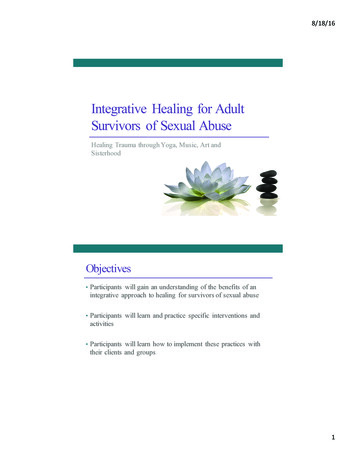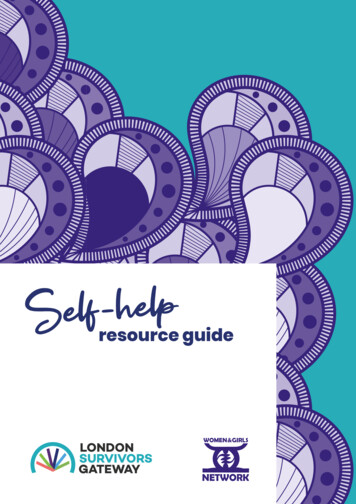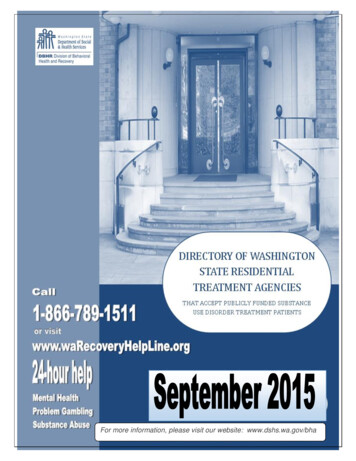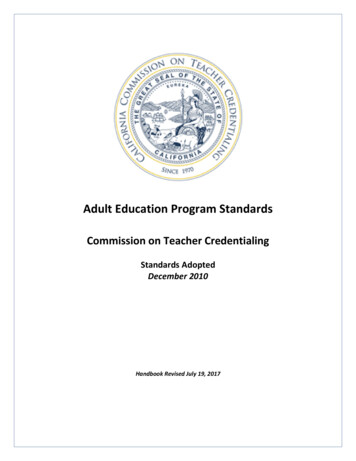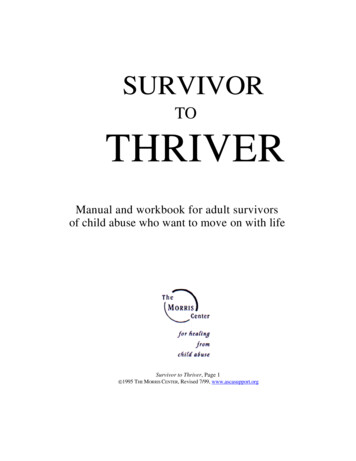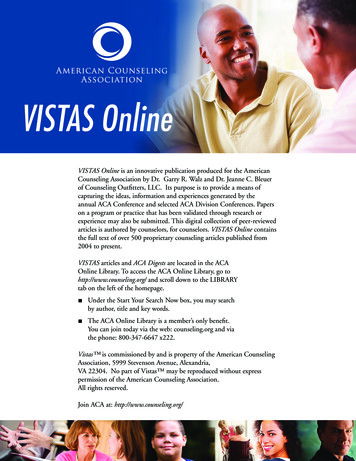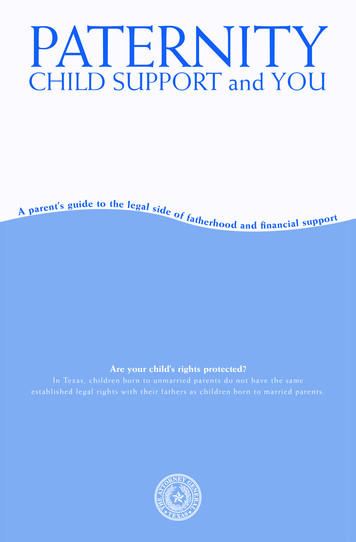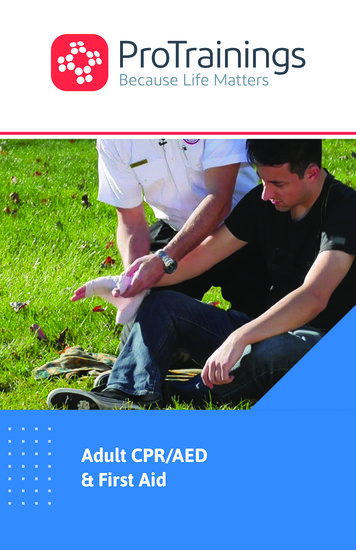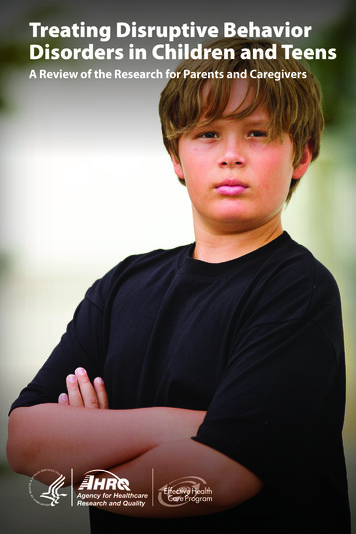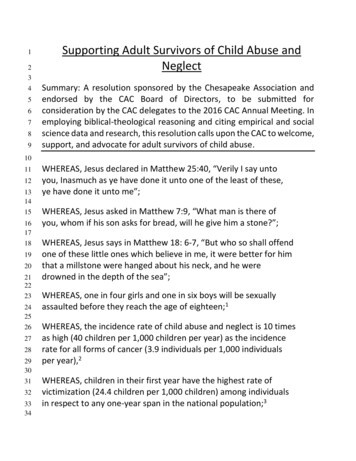
Transcription
123456789Supporting Adult Survivors of Child Abuse andNeglectSummary: A resolution sponsored by the Chesapeake Association andendorsed by the CAC Board of Directors, to be submitted forconsideration by the CAC delegates to the 2016 CAC Annual Meeting. Inemploying biblical-theological reasoning and citing empirical and socialscience data and research, this resolution calls upon the CAC to welcome,support, and advocate for adult survivors of child 323334WHEREAS, Jesus declared in Matthew 25:40, “Verily I say untoyou, Inasmuch as ye have done it unto one of the least of these,ye have done it unto me”;WHEREAS, Jesus asked in Matthew 7:9, “What man is there ofyou, whom if his son asks for bread, will he give him a stone?”;WHEREAS, Jesus says in Matthew 18: 6-7, “But who so shall offendone of these little ones which believe in me, it were better for himthat a millstone were hanged about his neck, and he weredrowned in the depth of the sea”;WHEREAS, one in four girls and one in six boys will be sexuallyassaulted before they reach the age of eighteen;1WHEREAS, the incidence rate of child abuse and neglect is 10 timesas high (40 children per 1,000 children per year) as the incidencerate for all forms of cancer (3.9 individuals per 1,000 individualsper year),2WHEREAS, children in their first year have the highest rate ofvictimization (24.4 children per 1,000 children) among individualsin respect to any one-year span in the national population;3
3536WHEREAS, 80% of perpetrators are parents;437WHEREAS, Adverse Childhood Experiences (ACES), or the variousforms of abuse and neglect (e.g., psychological, physical, sexual)that children experience often as a result of householddysfunction (e.g., domestic violence, substance abuse, mentalillness), are the most preventable causes of serious mental illness,drug and alcohol abuse in women, and of high-risk behavior (IVdrugs, promiscuity) for HIV, as well as significant contributors tothe leading causes of death in the general population (heartdisease, cancer, stroke, diabetes, and 58596061626364656667WHEREAS, ACES have a negative impact on child development, asmanifested in adverse neurobiological effects (e.g., brainabnormalities, stress hormone dysregulation), deleteriouspsychosocial consequences (e.g., poor attachment, poor socialization,poor self-efficacy), and significant health-risk behaviors (e.g., smoking,obesity, substance abuse, promiscuity);6WHEREAS, ACES also have significant long long-term consequences,including the occurrence and recurrence of various diseases anddisabilities (major depression, suicide, PTSD, drug and alcohol abuse,heart disease, cancer, chronic lung disease, sexually transmitteddiseases, intergenerational transmission of abuse) and assorted socialproblems, (homelessness, prostitution, criminal behavior, dysfunctionalparenting, inordinate utilization of health and social services), oftenresulting in shortened lifespans;7WHEREAS, the estimated total lifetime financial costs associated withall confirmed cases of child maltreatment (physical abuse, sexual abuse,psychological abuse and neglect) is approximately 124 billion for everyyear of maltreatment;82
93949596979899WHEREAS, many survivors of child abuse and neglect often experiencespiritual struggles in the course of healing, trying to come closer to Godas they question how God could allow such abuse and neglect tohappen in the first place.9 Indeed, trauma can shake people’s faith in anatural or divine order and cast them into a state of existential crisiswhereby they begin to lose trust in an all-powerful and good God,assume that their world is anything but safe and well-ordered, andbelieve that they are wicked and deserving of bad outcomes;10Whereas, for some survivors, the loss of positive religious beliefs(e.g., in the goodness of others, in spiritual and faith traditions, in abeneficent God) or the learning of negative religious beliefs (e.g., thatbad things happen because of divine sanction or retribution forindividual sin or sins) that often accompanies traumatization can bedebilitating. Indeed, such loss or learning can fuel the shame, guilt,despair, and hopelessness that undergird suicidality and harmful risktaking, as well as negatively impact the ability and desire to show loveto others.11WHEREAS, insofar as the retention or acquirement of religious beliefsand spirituality protects some survivors against suicide or contributesmore generally to their process of healing, the traumatized may alsocome to a point in their recovery when they benefit by giving serviceback to others, both within and outside their religious community.Finding ways that survivors can serve others or contribute to a highercause can help them find meaning and purpose in what they haveexperienced and in their lives. Often the survivors’ religious communitycan facilitate this kind of service, helping them to take down the wallsthey have put up to protect themselves. 12WHEREAS, abused children normally don’t tell anyone about theirabuse; and even when they become adults, they either never tell3
100101102103104anyone or wait for years/decades before disclosing their abuse becauseof the fear of negative responses from others;13WHEREAS, not one President or any member of Congress in the historyof our country has ever put the plight of adult survivors of child abuseon the national agenda;105106107WHEREAS, there has been no national discussion in the media aboutthe plight of adult survivors of child abuse and neglect; and108109110111112WHEREAS, there is no national database to report accurately on thenumber of adult survivors of child abuse and neglect in the UnitedStates, thus negatively impacting the capacity to provide adequateservices for survivors;14113114115116117118119120121THEREFORE, BE IT RESOLVED, that the Central Atlantic Conferenceof the United Church of Christ reaffirm and support past GeneralSynod Resolutions advocating for the welfare of children and now callthe church to address publicly the healing needs of adult survivors ofchild abuse and neglect by reinforcing the truth that survivors are notto blame for their victimization and that the United Church of Christwelcomes them in experiencing God’s love and compassion withinthe church community;15122123124125126127128129BE IT FURTHER RESOLVED, that each association and congregation ofthe Central Atlantic Conference be encouraged to educate its membersthat adult survivors are, for the most part, invisible because of thecompulsion they have felt since childhood not to self-disclose, as wellas to train its church members to react positively to those who areready to self-disclose (probably for the first time) through responsesthat are accepting, validating, non-judgmental, and non-pressuring;130131132BE IT FURTHER RESOLVED, that the Central Atlantic Conference workwith state and federal representatives to strengthen the Americans4
133134135136137138139140141142143144with Disabilities Act so that mental disabilities are accommodated justas much as physical disabilities in the workplace; encourage state andfederal lawmakers to develop a standardized method of reporting childmental, emotional, physical, and sexual abuse and/or neglect byclinicians, criminal justice organizations, social service providers,healthcare organizations, insurance companies, researchers, and publicpolicy makers; encourage state and federal lawmakers to eliminate thestatute of limitations for child abuse and neglect, as such a statuteinfringes upon the procedural due process rights of adult survivors ofchild abuse and neglect by denying them access to the courts; and workwith the media and state and federal legislators to focus strongly on theneed to support adult survivors; and145146147148BE IT FURTHER RESOLVED, that this resolution, if approved, be put inthe proper form by the Board of Directors of the Central AtlanticConference for submission to General Synod .htm ACE Study - Prevalence – Adverse Childhood ExperiencesChild Welfare League of America, “Testimony submitted to the House Subcommittee on Select Education of theCommittee on Education and the Workforce for the hearing on CAPTA: Successes and Failures at PreventingChild Abuse, August 2, 2001”3HHS Releases National Statistics on Child Abuse and Neglect for 2006, U.S. Department of Health and HumanServices, Child Maltreatment rg/maltreatment/trauma/can narrative Documents/training/SanJosePlenaryTICW 01 child abuse.html9Walker, D. F., C. A. Courtois, and J. D. Aten (Eds.), (2015) Spiritually Oriented Psychology for Trauma,American Psychological Association.10Herman, J. (1992). Trauma and Recovery: The Aftermath of Violence—from Domestic Abuse to Political Terror.New York, NY: Basic Books.11Colucci, E., & G. Martin (2008). “Religion and Spirituality along the Suicidal Path.” Suicide and Life-ThreateningBehavior, 38, 229-244.12Richards, P.S., & A.E. Bergin (Eds.). (2000). Handbook of Psychotherapy and Religious Diversity. Washington,DC: American Psychological Association.13Ullman, Sarah E. (2003). “Social Reactions to Child Sexual Abuse Disclosures: A Critical Review.” Journal ofChild Sexual Abuse, Vol. 12 (1) ide/statistics/nis/#n415 Past UCC resolutions advocating for child welfare include: (1) 1983 GS 14 – Child Abuse &Exploitation of Youth; (2) 1993 GS 19 – In Support of the Rights of God’s Children; (3)1995 GS 20 – Creating a World Safe for Children Free from Violence.125
RESOURCES1.Allies in Healing; When the Person You Love Was Sexually Abused as a Child, by L. Davis, MA (1991).2.Amongst Ourselves: A Self-Help Guide to Living with Dissociative Identity Disorder, by T. Alderman, PhD &K. Marshall, LCSW (1988).3.Beyond Betrayal: Taking Charge of Your Life after Boyhood Sexual Abuse, by R.B. Gartner, PhD (2005).4.Childhood Comes First: A Crash Course in Childhood for Adults, by R. B. Gartner, PhD (2005).5.Conquering Incest: My Life as a Trauma Survivor, by Diane Champé (2011).6.Cutting: Understanding and Overcoming Self-Mutilation, by Steven Levenkron, MD (1988).7.Got Parts? An Insider’s Guide to Managing Life Successfully with Dissociative Identity Disorder, by A. T. W.(2005).8.Growing Beyond Survival: A Self-Help Toolkit for Managing Traumatic Stress (Revised Edition), by ElizabethG. Vermilyea, PhD (2013).9.http://www.naasca.org/Graphics/ ChildAbuseLives/CAlives-600x800-text.htm.10. I Can’t Get Over It: A Handbook for Trauma Survivors, by Aphrodite Matsakis, PhD (1992).11. It’s Not You, It’s What Happened to You: Complex Trauma and Treatment, by Christine Courtois, PhD, ABPP,LLC (2014).12. Life After Trauma: A Workbook for Healing, by Dena Rosenbloom & Mary Beth Williams (Second Edition;2010).13. Parenting from the Inside Out: How a Deeper Understanding Can Help You Raise Children Who Thrive, byDaniel Siegel, MD (Tenth Anniversary Edition; 2013).14. The Courage to Heal: A Guide for Women Survivors of Child Sexual Abuse, by Ellen Bass, MS & Laura Davis,MA (2009).15. Writing to Heal: A Guide Journal for Recovering from Trauma & Emotional Upheaval, by James W.Pennebaker, PhD (2004).15 Your Surviving Spirit: A Spiritual Workbook for Coping with Trauma, by Dusty Miller, EdD (2003).For further information, please contact the resolution’s author, Diane Champé,edchampe@msn.com.6
2 35 WHEREAS, 80% of perpetrators are parents;4 36 37 WHEREAS, Adverse Childhood Experiences (ACES), or the various 38 forms of abuse and neglect (e.g., psychological, physical, sexual) 39 that children experience often as a result of household 40 dysfunction (e.g., domestic violence, substance abuse, mental 41 illness), are the most preventable causes of serious mental illness,
